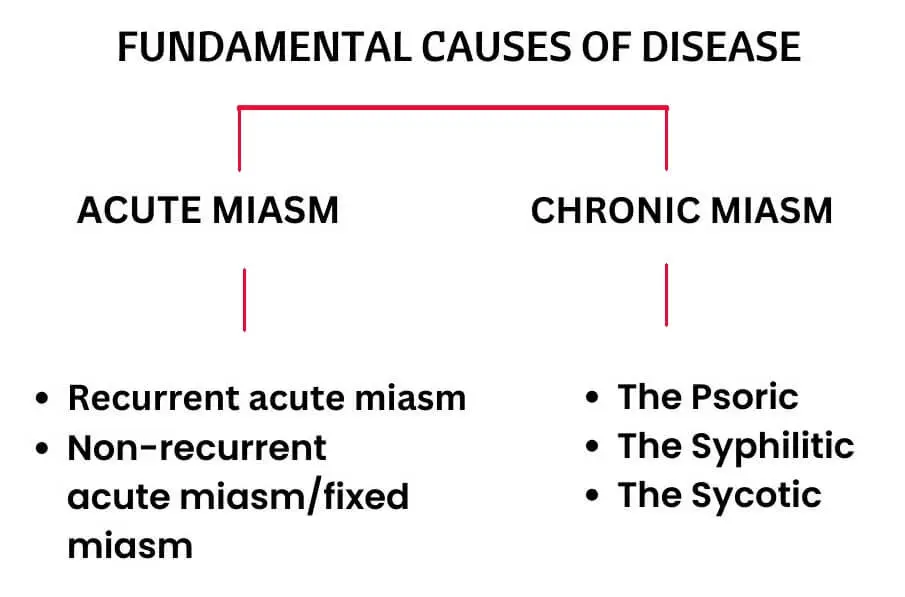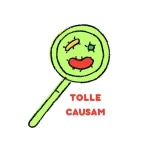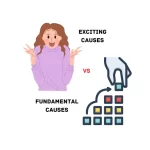
Fundamental causes of the diseases in homoeopathy are one of the most important subjects that should be understood carefully by the practicing homoeopaths.
Table of Contents
ToggleDEFINITION
Causes that are primarily or basically responsible for the disease development are known as the fundamental causes.
While working on chronic diseases Dr. Hahnemann found that even carefully selected homoeopathic remedies failed to give permanent results.
Diseases were either reoccurring or continued to progress.
So, he occupied himself to find out the root causes behind those chronic diseases.
He observed that, there is some pattern and characteristics in almost all the diseases.
Then he classified the disease states based on their pattern.
He used the word “MIASM” to describe this disease classification.
Ref: Miasm word is derived from a Greek word “Miasmein”. A similar Latin word is also found “Miasma.” Both means pollution or stigma.

Hahnemann classified Miasms into broadly 2 types.
- Acute miasms
- Chronic miasms
1. ACUTE MIASM
Theme: There is a feeling of strong threat from outside world with strong, sudden, and violent reaction.
Acute miasms are of two types.
- Recurrent acute miasm: attacks a person many times in same manner.
Example: Cholera, plague etc.
- Non-recurrent acute miasm/fixed miasm: attacks a person only once.
Example: Chicken pox, measles, whooping cough etc.
2. CHRONIC MIASM
There is period of prodromal and progress with no period of recession or end.
May pass from one generation to other generation.
Dr. Hahnemann introduced 3 types of chronic miasms.
- The Psoric miasm
Theme: he must struggle to recover or maintain his position or success.
- The Sycotic miasm
Theme: feeling of fixed, irreversible weakness within himself so he tries to hide it from others.
- The Syphilitic miasm
Theme: feeling of complete hopelessness and despair with response of drastic do-or-die attempt to change either himself or environment.
Slow a strong pessimism and destructiveness.
Concept of Miasms
- Acute: Threatening
- Psoric: Struggle
- Sycotic: Weakness
- Syphilic: Destructiveness
WHAT IS THE IMPORTANCE OF KNOWING FUNDAMENTAL CAUSES?
- Knowledge of Miasms helps to understand the nature of diseases and nature of homoeopathic medicines.
- We can understand the element of the case.
- Based on the reaction type of each Miasm we can differentiate each case.
Examples:
Acute miasm will react instinctively.
Psoric patient will struggle.
Sycotic patient will try to hide or conceal.
Syphilitic patient will collapse or strike back.
- We can predict the prognosis of the case.
Examples:
Acute cases have best prognosis whereas, syphilitic cases have poorest prognosis.
- We can anticipate the course of remedies that might be required in a case.
Examples:
If syphilitic case is treated, a Psoric root can surface.
Read the HERING’S LAW OF CURE in detail by following the link.
HOW TO INVESTIGATE THE FUNDAMENTAL CAUSES OF THE DISEASES?
Dr. Hahnemann recommended some factors that can be examined while case taking.
- Constitution of the patient
- Age and gender of the patient
- Occupation
- Moral and intellectual values
- Mode of living and habits
- Social and family relationships
- Sexual behavior
CONCLUSION
Dr. Hahnemann suggested a THEORY OF CAUSATION/ THEORY OF CHRONIC DISEASES.
Miasmatic concept of diseases is just not the theory of causation, but it is a practical classification of the disease states.













Leave a Reply